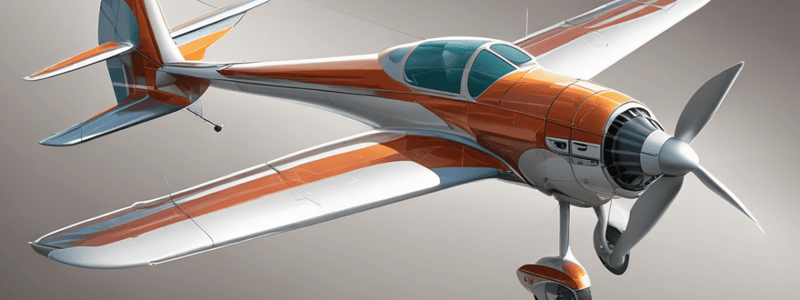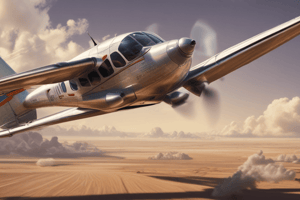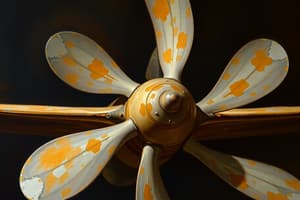Podcast
Questions and Answers
What is the primary function of an aircraft's wings?
What is the primary function of an aircraft's wings?
- To provide stability and support
- To reduce drag forces
- To produce lift (correct)
- To generate thrust
Which type of wing design is best suited for supersonic aircraft?
Which type of wing design is best suited for supersonic aircraft?
- Delta wings (correct)
- Swept wings
- Straight wings
- High aspect ratio wings
What is the primary benefit of high aspect ratio wings?
What is the primary benefit of high aspect ratio wings?
- Increased maneuverability
- Enhanced thrust generation
- Improved stability
- Reduced drag and increased lift efficiency (correct)
Why are swept wings commonly found on commercial jet airliners?
Why are swept wings commonly found on commercial jet airliners?
What determines the efficiency of a wing?
What determines the efficiency of a wing?
What is the primary advantage of low aspect ratio wings?
What is the primary advantage of low aspect ratio wings?
Why do straight wings excel at slower speeds?
Why do straight wings excel at slower speeds?
What is the primary goal of aerodynamic design in aircraft?
What is the primary goal of aerodynamic design in aircraft?
What determines the suitability of a wing design for a particular flight regime?
What determines the suitability of a wing design for a particular flight regime?
What is the primary benefit of carefully designing an aircraft's wings and propellers?
What is the primary benefit of carefully designing an aircraft's wings and propellers?
The design of an aircraft's propeller affects only the drag forces that act upon the aircraft.
The design of an aircraft's propeller affects only the drag forces that act upon the aircraft.
High aspect ratio wings are typically found on fighter jets.
High aspect ratio wings are typically found on fighter jets.
Aerodynamic design is primarily focused on reducing fuel consumption.
Aerodynamic design is primarily focused on reducing fuel consumption.
Delta wings are characterized by their rearward angle.
Delta wings are characterized by their rearward angle.
Swept wings are commonly found on light aircraft.
Swept wings are commonly found on light aircraft.
The aspect ratio of a wing is the relationship between its length and width.
The aspect ratio of a wing is the relationship between its length and width.
Low aspect ratio wings are more efficient at producing lift.
Low aspect ratio wings are more efficient at producing lift.
Straight wings are prevalent on supersonic aircraft.
Straight wings are prevalent on supersonic aircraft.
Gliders and long-haul aircraft typically have low aspect ratio wings.
Gliders and long-haul aircraft typically have low aspect ratio wings.
The shape of a wing determines its aerodynamic properties.
The shape of a wing determines its aerodynamic properties.
What aerodynamic properties make delta wings suitable for supersonic aircraft?
What aerodynamic properties make delta wings suitable for supersonic aircraft?
How do high aspect ratio wings contribute to the efficiency of gliders and long-haul aircraft?
How do high aspect ratio wings contribute to the efficiency of gliders and long-haul aircraft?
What is the primary advantage of using swept wings on commercial jet airliners?
What is the primary advantage of using swept wings on commercial jet airliners?
How do engineers determine the most appropriate wing shape and propeller characteristics for an aircraft?
How do engineers determine the most appropriate wing shape and propeller characteristics for an aircraft?
What is the primary benefit of understanding and applying aerodynamics in aircraft design?
What is the primary benefit of understanding and applying aerodynamics in aircraft design?
What is the primary advantage of low aspect ratio wings on fighter jets?
What is the primary advantage of low aspect ratio wings on fighter jets?
How do the unique aerodynamic properties of different wing designs affect the flight regime of an aircraft?
How do the unique aerodynamic properties of different wing designs affect the flight regime of an aircraft?
What is the primary role of wing design in the overall performance of an aircraft?
What is the primary role of wing design in the overall performance of an aircraft?
How do propeller and wing designs work together to impact the flight efficiency of an aircraft?
How do propeller and wing designs work together to impact the flight efficiency of an aircraft?
What is the primary goal of aircraft designers when it comes to wing and propeller design?
What is the primary goal of aircraft designers when it comes to wing and propeller design?
Flashcards are hidden until you start studying
Study Notes
Propeller Design
- Propellers are critical components that influence an aircraft's efficiency and thrust.
- They work by slicing through the air at a precise angle, creating a difference in air pressure that propels the aircraft forward (aerodynamic lift).
- The main components of a propeller are the blades and the hub.
- The shape of a propeller blade is finely tuned to maximize efficiency, similar to how an aircraft's wing is shaped to produce adequate lift.
- The pitch, or the twist of the blades, determines the angle of attack, with a higher pitch meaning the blade is angled more steeply, increasing thrust but requiring more engine power.
Propeller Size and RPM
- Larger propellers moving slowly can produce the same amount of thrust as smaller ones moving quickly, but with improved efficiency and less noise.
- Propeller size and RPM are crucial aspects in aircraft performance design.
- Variations in propeller design directly affect fuel efficiency and speed.
Wing Design
- Wings are a primary factor dictating an aircraft's performance, and their design intricacies play a vital role in optimizing flight characteristics such as thrust, lift, and overall aerodynamic efficiency.
- The shape of the wing is pivotal in creating lift, with the curvature (camber) and cross-sectional shape directly affecting how air moves over and under the wing.
- The approach to wing design blends science and artistry, with different types of wings (straight, swept, and delta) offering unique aerodynamic advantages and limitations.
Wing Characteristics
- Aspect ratio is the wing's span divided by its average width, influencing flight characteristics like glide efficiency and maneuverability.
- Wing loading is the weight of the airplane per area of the wing, influencing the aircraft's speed, fuel efficiency, and smoothness in turbulence.
- Winglets are a design feature that mitigates wingtip vortices, reducing drag and enhancing range.
Future of Wing Technology
- Recent advancements in materials like carbon fiber composites are revolutionizing modern wing manufacturing, making them lighter and stronger.
- Innovations like morphing wings may soon allow aircraft to adapt their shape in-flight, optimizing performance in real time.
Interconnection of Wing and Propeller Design
- The design of a wing and propeller is interconnected, with changes in one affecting the other.
- Efficient wing and propeller design is crucial for reducing fuel consumption, improving overall performance, and enhancing the sustainability of aircraft.
Propeller Design
- Propellers are critical components that influence an aircraft's efficiency and thrust.
- They work by slicing through the air at a precise angle, creating a difference in air pressure that propels the aircraft forward (aerodynamic lift).
- The main components of a propeller are the blades and the hub.
- The shape of a propeller blade is finely tuned to maximize efficiency, similar to how an aircraft's wing is shaped to produce adequate lift.
- The pitch, or the twist of the blades, determines the angle of attack, with a higher pitch meaning the blade is angled more steeply, increasing thrust but requiring more engine power.
Propeller Size and RPM
- Larger propellers moving slowly can produce the same amount of thrust as smaller ones moving quickly, but with improved efficiency and less noise.
- Propeller size and RPM are crucial aspects in aircraft performance design.
- Variations in propeller design directly affect fuel efficiency and speed.
Wing Design
- Wings are a primary factor dictating an aircraft's performance, and their design intricacies play a vital role in optimizing flight characteristics such as thrust, lift, and overall aerodynamic efficiency.
- The shape of the wing is pivotal in creating lift, with the curvature (camber) and cross-sectional shape directly affecting how air moves over and under the wing.
- The approach to wing design blends science and artistry, with different types of wings (straight, swept, and delta) offering unique aerodynamic advantages and limitations.
Wing Characteristics
- Aspect ratio is the wing's span divided by its average width, influencing flight characteristics like glide efficiency and maneuverability.
- Wing loading is the weight of the airplane per area of the wing, influencing the aircraft's speed, fuel efficiency, and smoothness in turbulence.
- Winglets are a design feature that mitigates wingtip vortices, reducing drag and enhancing range.
Future of Wing Technology
- Recent advancements in materials like carbon fiber composites are revolutionizing modern wing manufacturing, making them lighter and stronger.
- Innovations like morphing wings may soon allow aircraft to adapt their shape in-flight, optimizing performance in real time.
Interconnection of Wing and Propeller Design
- The design of a wing and propeller is interconnected, with changes in one affecting the other.
- Efficient wing and propeller design is crucial for reducing fuel consumption, improving overall performance, and enhancing the sustainability of aircraft.
Propeller Design
- Propellers are critical components that influence an aircraft's efficiency and thrust.
- They work by slicing through the air at a precise angle, creating a difference in air pressure that propels the aircraft forward (aerodynamic lift).
- The main components of a propeller are the blades and the hub.
- The shape of a propeller blade is finely tuned to maximize efficiency, similar to how an aircraft's wing is shaped to produce adequate lift.
- The pitch, or the twist of the blades, determines the angle of attack, with a higher pitch meaning the blade is angled more steeply, increasing thrust but requiring more engine power.
Propeller Size and RPM
- Larger propellers moving slowly can produce the same amount of thrust as smaller ones moving quickly, but with improved efficiency and less noise.
- Propeller size and RPM are crucial aspects in aircraft performance design.
- Variations in propeller design directly affect fuel efficiency and speed.
Wing Design
- Wings are a primary factor dictating an aircraft's performance, and their design intricacies play a vital role in optimizing flight characteristics such as thrust, lift, and overall aerodynamic efficiency.
- The shape of the wing is pivotal in creating lift, with the curvature (camber) and cross-sectional shape directly affecting how air moves over and under the wing.
- The approach to wing design blends science and artistry, with different types of wings (straight, swept, and delta) offering unique aerodynamic advantages and limitations.
Wing Characteristics
- Aspect ratio is the wing's span divided by its average width, influencing flight characteristics like glide efficiency and maneuverability.
- Wing loading is the weight of the airplane per area of the wing, influencing the aircraft's speed, fuel efficiency, and smoothness in turbulence.
- Winglets are a design feature that mitigates wingtip vortices, reducing drag and enhancing range.
Future of Wing Technology
- Recent advancements in materials like carbon fiber composites are revolutionizing modern wing manufacturing, making them lighter and stronger.
- Innovations like morphing wings may soon allow aircraft to adapt their shape in-flight, optimizing performance in real time.
Interconnection of Wing and Propeller Design
- The design of a wing and propeller is interconnected, with changes in one affecting the other.
- Efficient wing and propeller design is crucial for reducing fuel consumption, improving overall performance, and enhancing the sustainability of aircraft.
Studying That Suits You
Use AI to generate personalized quizzes and flashcards to suit your learning preferences.




